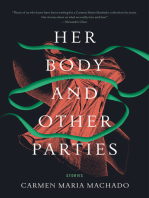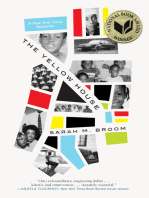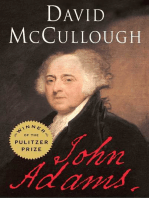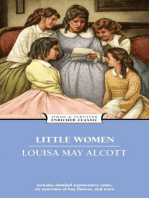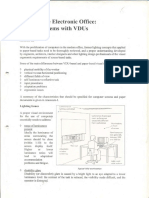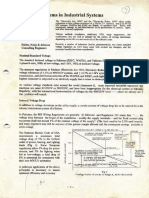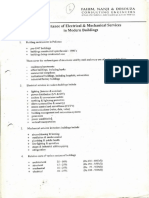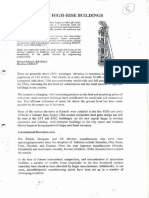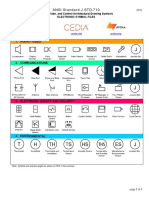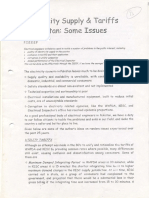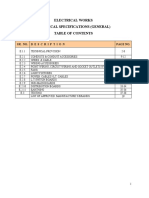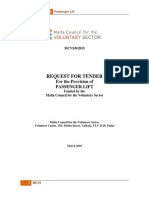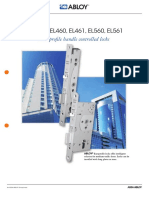Professional Documents
Culture Documents
Lighting With Economy
Lighting With Economy
Uploaded by
naveedfnd0 ratings0% found this document useful (0 votes)
29 views6 pagestechnical paper on lighting
Original Title
Lighting with Economy
Copyright
© © All Rights Reserved
Available Formats
PDF or read online from Scribd
Share this document
Did you find this document useful?
Is this content inappropriate?
Report this Documenttechnical paper on lighting
Copyright:
© All Rights Reserved
Available Formats
Download as PDF or read online from Scribd
Download as pdf
0 ratings0% found this document useful (0 votes)
29 views6 pagesLighting With Economy
Lighting With Economy
Uploaded by
naveedfndtechnical paper on lighting
Copyright:
© All Rights Reserved
Available Formats
Download as PDF or read online from Scribd
Download as pdf
You are on page 1of 6
Roland deSouza, PLE.
(Member, Iitumination Society of Pakistan
Member, indian Society af Lighting Engineers
Phan a din eens empire arte a mars tence by. econ
‘comniderapin. Three techniques that casts
igues that optimise capital or epératicg
All designers, engineers or architects, would love to have a Mughal badshah as a patron of
their art, a sponsor or client who has no financial constraints, and affords the designer the
complete freedom to create and plan as he wishes Unfortunately the Mughal era is past, and
we live today in an age of economic limitations — and building energy codes. One cannot just
create and plan without keeping 4 sharp eye on the financial pros and cons of warious
alternatives, thus trying tor evolve optimum solutions
‘Economics plays a major Ee in a choice and application of lighting solutions. Ax the Memons
are fond of saying: “Beso pir na Mooso pir, badhay sey wadho paiso pir * Three techniques
will be examined in this paper: judicious application in the correct circumstances can provide
substantial capital savings of short paybacks.
irchandli
In a typical office interior in Karachi, approximately 10% - 15% of the heat gains within a
space are generated by the lighting system. If the air-handling (seturn-air) is integrated with
ths luminaire, by providing slots behind the lemps, most of this heat is removed direetly
without entering the interior space This reduces air-flow requirements substantially, the
connected load by 2.5% - 5% and the consequent energy expended in the air-conditioning
system by 1% - 3%
‘The three types of integrated air-conditioning and lighting systems are shown in Fig. |
mses cal ‘neato Rom ito of pa ie inceated by he
(7) postive pressare 6) negative presnre.
‘With cool air passing over the lamps and fixture body, three extra benefits emerge: ;
© the comfort of occupants is improved as the heat radiation from lower temperature lamps
and light fixtures is reduced
% the luminous flux and efficiency of the fluorescent lamps increases 5% - 10% (Fig:2)
dirt accumulation on lamps is reduced.
‘Additionally, the supply-air diffasers ina linear form can be ‘ ae
made part of the light fixture (Annexure-1) to provide a
‘compact, well-formed unit, The visual “noise” in the false
ceiling, with luminaires, supply-air registers, and returo-air
grilles, is eliminated. Surprisingly, this improvement in ©
aesthetics comes along with a reduction in price.
Bae
Annexure-2 shows a comparison of three altematives for = : eee.
lighting and air-handling, with air-handling luthinsires | a
providing the optimum solution, allowing maximum o 2 oe ake
flexibility in relocation of interior partitions as supply and
retum air is available everywhere. fe lr faeces
Sree ar on of
at and
To summarise, the advantages of integrated lighting and
air-bandling include
reduced (1% - 396) air-conditioning operating costs
0 reduced heat radiation from lamps & light fixtures .
© increased (5% - 10%) light output from cooler-cunning lamps,
‘0 improvement in falsc-ceiling sesthetics
increased flexibility in lotation of interior partitions at lower capital costs
Today less that 10% of air-conditioned commercial interiors in Pakistan use air-handling,
luminaires: this needs to be changed.
Triphosphor Lamps
In Pakistan, Cool Daylight (6200°K) halophosphate-coated flourescent lamps have been used
exclusively up to three or four years ago. Due to the limited market in the country,
manufacturers cannot afford to produce a range of colours and opted for the one that best
suits the warm climate.
Recently, however, triphosphor fluorescent lamps have been imported by a number of parties
and their use is increasing. The main comparative characteristics of the lamps are given in
Fig. 3.
—
‘Bo IB
[eso [soe0 | 3000}
esac ne [6g gs
a Cr
2500 (40m) | 3000 3350
1030 aw) | 1350.
Rem F120
Fig. 5. Comparative characteristics of fluorescent lamps.
—
sae = Se)
fos
‘The advantages of these three-band fluorescent lamps include
? low power consumption (36 instead of 40W)
© longer service life
© lower lumen depreciation
© high luminous efficacy (34% higher)
© very good (vibranu/natural) colour-rendering properties
The Building Energy Code of Pakistan (1990) recommends a lighting power budget of
20Wim? for offices: with the use of the new generation of trighosphor lamps it should be
possible to reduce this to around 15 Wim?
The number of luminaires could be reduced by upto 25% (when compared to fixtures with
cortventional tubes) to achieve the same lighting levels: the optics and light distribution
characteristics would have to be improved in order to provide an acceptable uniformity of
Mlumination with fewer fixtures. Thus the initial capital cost of the lighting installation can be
reduced -— along with a sustained reduction im operating and enezgy costs (including the
thermal effects on the air conditioning, system). ‘
‘To summarise, the benefits.of using the tripbosphor Nuorescent lamps include
% lower capital costs (upth 25% less) of lighting installations
> lower maintenance costs as lamp luminous flux depreciation is negligible
© improvement in interior appearances owing to superior colour rendition.
In would thus seem that there is no reason to use anything but the triphosphor lamp in
commercial, industrial, and institutional installations today
Compact Fluorescent Lamps
‘With the popular nickname of “energy-savers”, the CFL have not yet been properly applied in
® number of situations in commercial, residential, and institutional projects in Pakistan. A lack
of knowledge of the exact benefits and payback periods for the extra investment has probably
‘been a contributing factor.
‘The comparative characteristics of some lamps commonly used in interiors are given below
Apa
Fig. 4. Comparative characterisnes af intertew- dight sources,
‘From a study of the above figures it can be seen that
© the CFL is an “energy-saving” substieute for the incandescent lamp, but does not compare
well with tubular fluorescent lamps, which have equal or better luminous efficiencies. at
much lower prices.
© “energy-saving” does not necessarily mean “economical”: an analysis must be made of the
payback period for the extra capital cost, and as shown in Fig. 4, the simple payback
[periods depend on
+ the number of operation hours in a
year
+ the cast of electric energy in a
particular situation
Generally paybacks of more than +
years are not very attractive and
thus CFLs find their applications in
commercial offices, banks, hotels,
hospitals and other installations with
operatibn in excess of 2500
hours/anoum, and energy costs in
excess of Rs.3.00/KWh
In Conclusion
In this day, when being “lean and
mean" is desirable, the lighting
designer must temper his creativity
and art with a knowledge of
economics and energy conservation.
Utilisation of the above methods will
go towards realising his goals,
Fig. 5. Payback period (208 PLE‘ ws 100M GES) for vorions electricity costs
be
‘us Handling Luminaire @ Rs3.00 ch Nek OR
TAH-S00240L-3
(Sepply & return sirwoit)
Luumisnire TAH-300289 Le} @ Re2e0u ech 4 Now RL LOO
(Dears seppty + return air unity
lnaallation charges a200" each 12 Non eso
Toa) _ fees
Supply alr differ R200 cach 2 Nos Ras coum
(Type AME 12" 13°)
‘Hletur a dieser @ Fsiso~ eek 4 Now Rx 6,000
(Type AME 12" x 12°)
‘Cenventioeal Lemsinaire @ «R190 ech 2 OO
‘TRE-IOWI40 L-3
Aeotallation anges @ Re cht 3,00
Total "Rs 64007
ee ‘Supply ae oe mE om 2 mi Rs21 aso
(BH Slot) 3:Sloe
LS. Rem ais diffuser a mse om 2s m@ Rs i2-500%
CM" Sloth 3 Slat
a Bam rh 50 rit Rao
Lumisaire TRE-200/240 L-3 8 Ralge t rhR Be
Remur rit Te
‘Total Reasons
i me
Ene Arwae Sacaat, ISP Workshop “Energy Conseration ia Lighting , Karachi
2 “inierior| "138 -
ie Teer & Fisebas, Esedboren,
4 Liphting ion
$ Fleorescent Lamp Catangue, 1994
(Roland deSouza is « Partner and Principal Electrical Engineer of Fahim, Naryi & deSouea,
multi-disciplinary firm of building services consultants in Pakistan).
You might also like
- The Subtle Art of Not Giving a F*ck: A Counterintuitive Approach to Living a Good LifeFrom EverandThe Subtle Art of Not Giving a F*ck: A Counterintuitive Approach to Living a Good LifeRating: 4 out of 5 stars4/5 (5838)
- The Gifts of Imperfection: Let Go of Who You Think You're Supposed to Be and Embrace Who You AreFrom EverandThe Gifts of Imperfection: Let Go of Who You Think You're Supposed to Be and Embrace Who You AreRating: 4 out of 5 stars4/5 (1093)
- Never Split the Difference: Negotiating As If Your Life Depended On ItFrom EverandNever Split the Difference: Negotiating As If Your Life Depended On ItRating: 4.5 out of 5 stars4.5/5 (862)
- Grit: The Power of Passion and PerseveranceFrom EverandGrit: The Power of Passion and PerseveranceRating: 4 out of 5 stars4/5 (591)
- Hidden Figures: The American Dream and the Untold Story of the Black Women Mathematicians Who Helped Win the Space RaceFrom EverandHidden Figures: The American Dream and the Untold Story of the Black Women Mathematicians Who Helped Win the Space RaceRating: 4 out of 5 stars4/5 (903)
- Shoe Dog: A Memoir by the Creator of NikeFrom EverandShoe Dog: A Memoir by the Creator of NikeRating: 4.5 out of 5 stars4.5/5 (542)
- The Hard Thing About Hard Things: Building a Business When There Are No Easy AnswersFrom EverandThe Hard Thing About Hard Things: Building a Business When There Are No Easy AnswersRating: 4.5 out of 5 stars4.5/5 (351)
- Elon Musk: Tesla, SpaceX, and the Quest for a Fantastic FutureFrom EverandElon Musk: Tesla, SpaceX, and the Quest for a Fantastic FutureRating: 4.5 out of 5 stars4.5/5 (474)
- Her Body and Other Parties: StoriesFrom EverandHer Body and Other Parties: StoriesRating: 4 out of 5 stars4/5 (824)
- The Sympathizer: A Novel (Pulitzer Prize for Fiction)From EverandThe Sympathizer: A Novel (Pulitzer Prize for Fiction)Rating: 4.5 out of 5 stars4.5/5 (122)
- The Emperor of All Maladies: A Biography of CancerFrom EverandThe Emperor of All Maladies: A Biography of CancerRating: 4.5 out of 5 stars4.5/5 (271)
- The Little Book of Hygge: Danish Secrets to Happy LivingFrom EverandThe Little Book of Hygge: Danish Secrets to Happy LivingRating: 3.5 out of 5 stars3.5/5 (405)
- The World Is Flat 3.0: A Brief History of the Twenty-first CenturyFrom EverandThe World Is Flat 3.0: A Brief History of the Twenty-first CenturyRating: 3.5 out of 5 stars3.5/5 (2259)
- The Yellow House: A Memoir (2019 National Book Award Winner)From EverandThe Yellow House: A Memoir (2019 National Book Award Winner)Rating: 4 out of 5 stars4/5 (98)
- Devil in the Grove: Thurgood Marshall, the Groveland Boys, and the Dawn of a New AmericaFrom EverandDevil in the Grove: Thurgood Marshall, the Groveland Boys, and the Dawn of a New AmericaRating: 4.5 out of 5 stars4.5/5 (268)
- A Heartbreaking Work Of Staggering Genius: A Memoir Based on a True StoryFrom EverandA Heartbreaking Work Of Staggering Genius: A Memoir Based on a True StoryRating: 3.5 out of 5 stars3.5/5 (232)
- Team of Rivals: The Political Genius of Abraham LincolnFrom EverandTeam of Rivals: The Political Genius of Abraham LincolnRating: 4.5 out of 5 stars4.5/5 (234)
- On Fire: The (Burning) Case for a Green New DealFrom EverandOn Fire: The (Burning) Case for a Green New DealRating: 4 out of 5 stars4/5 (74)
- The Unwinding: An Inner History of the New AmericaFrom EverandThe Unwinding: An Inner History of the New AmericaRating: 4 out of 5 stars4/5 (45)
- T02 - Audiovisual Systems 2022Document23 pagesT02 - Audiovisual Systems 2022naveedfndNo ratings yet
- Lighting The Electronic Glare Problems With VdusDocument13 pagesLighting The Electronic Glare Problems With VdusnaveedfndNo ratings yet
- Voltage Problems in Industrial SystemsDocument9 pagesVoltage Problems in Industrial SystemsnaveedfndNo ratings yet
- Importance of Electrical & MechDocument2 pagesImportance of Electrical & MechnaveedfndNo ratings yet
- Elevators in High Rise BuildingsDocument8 pagesElevators in High Rise BuildingsnaveedfndNo ratings yet
- Page 101Document1 pagePage 101naveedfndNo ratings yet
- Does Your Earthing System Provide SafetyDocument8 pagesDoes Your Earthing System Provide SafetynaveedfndNo ratings yet
- Summary ANSI J STD 710 Symbols Aug2018Document2 pagesSummary ANSI J STD 710 Symbols Aug2018naveedfndNo ratings yet
- Electricity Supply & TariffDocument6 pagesElectricity Supply & TariffnaveedfndNo ratings yet
- Distribution Generation Aluminium CablesDocument11 pagesDistribution Generation Aluminium CablesnaveedfndNo ratings yet
- SBA5.7Document5 pagesSBA5.7naveedfndNo ratings yet
- Earth Leakage ProtectionDocument6 pagesEarth Leakage ProtectionnaveedfndNo ratings yet
- Electrical Works Technical Specifications (General) : Sr. No.D E S C R I P T I O N Page NoDocument17 pagesElectrical Works Technical Specifications (General) : Sr. No.D E S C R I P T I O N Page NonaveedfndNo ratings yet
- A New Control System For High Rise ElevatorsDocument12 pagesA New Control System For High Rise ElevatorsnaveedfndNo ratings yet
- Direct On Line or Star DeltaDocument6 pagesDirect On Line or Star DeltanaveedfndNo ratings yet
- Electrical Equipment Floor Space: Application Paper AP083007ENDocument8 pagesElectrical Equipment Floor Space: Application Paper AP083007ENnaveedfndNo ratings yet
- X618 BrochureDocument8 pagesX618 BrochurenaveedfndNo ratings yet
- Request For Tender: For The Provision of Passenger LiftDocument40 pagesRequest For Tender: For The Provision of Passenger LiftnaveedfndNo ratings yet
- WavePro LT. Busway SystemDocument44 pagesWavePro LT. Busway SystemnaveedfndNo ratings yet
- Abloy: Europrofile Handle Controlled LocksDocument6 pagesAbloy: Europrofile Handle Controlled LocksnaveedfndNo ratings yet
- World Class: Electric LocksDocument32 pagesWorld Class: Electric LocksnaveedfndNo ratings yet
- 209 Guide To Security TurnstilesDocument13 pages209 Guide To Security TurnstilesnaveedfndNo ratings yet













